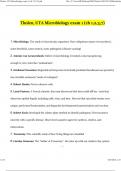Tholen, UTA Microbiology exam 1 (ch 1,2,3,7).pdf file:///C:/Users/HP/Desktop/NIW/Tholen,%20UTA%20Microbiolog
Tholen, UTA Microbiology exam 1 (ch 1,2,3,7)
1. Microbiology: The study of microscopic organisms. Have ubiquitous nature (everywhere),
some beneficial, some neutral, some pathogenic (disease-causing)
2. Antoine van Leeuwenhoek: Father of microbiology. Invented a microscopestrong
enough to view microbes "animalcules".
3. Giralamo Fracastoro: Regarded as first person to formally postulate that diseasewas spread by
tiny invisible seminaria "seeds of contagion".
4. Robert Hooke: First to observe cells.
5. Louis Pasteur: A French chemist, this man discovered that heat could kill bac- teria that
otherwise spoiled liquids including milk, wine, and beer. Showed that microbial strains were
unique, performed fermentation, and began the developmentof pasteurization and vaccines.
6. Robert Koch: Developed the culture plate method to identify pathogens. First toconnect
microbe with a specific disease. Discovered causative agent for anthrax, cholera, and
tuberculosis.
7. Taxonomy: The scientific study of how living things are classified
8. Carolus Linneaus: The "Father of Taxonomy". He came up with our modern day system
1/3
1 of 6 8/20/2024, 1:23
,Tholen, UTA Microbiology exam 1 (ch 1,2,3,7).pdf file:///C:/Users/HP/Desktop/NIW/Tholen,%20UTA%20Microbiolog
of classification called Binomial Nomenclature. Most famous early taxonomists. Divided 3
kingdoms animal, plant, and mineral. Sublevels: kingdom,class, order, family, genus, species
9. Phylogeny: The evolutionary history of a species or group of related species.
10. Ernst Haeckel: Father of ecology. Proposed another kingdom, protista, latermonera.
11. Robert Whittaker: added fungi as a 5th kingdom of eukaryotic microbes. Di- vided
kingdoms into prokaryote (monera) and eukaryote (fungi, protista, plantae,animalia)
12. Carl Woese and George Fox: Studied the small subunit of the ribosomeProposed a
separate taxonomic unit: Archaea.
Also proposed a new taxonomic system representing three domains: bacteria,archaea, and
eukarya.
13. Binomial nomenclature: Classification system in which each species is as- signed a two-
part scientific name. (Written in italics, Genus is capitalized, specieslower case)
14. Bergey's Manual of Bacteriology: Manual for identifying and classifying mi-
croorganisms via non-visual characteristics.
15. Taxonomy order: Domain, Kingdom, Phylum, Class, Order, Family, Genus,Species.
16. (T/F) within 1 species of a microorganism, there can be several subtypes called
strains.: True, can be nearly identical genetically.Every strain varies in abilityto cause disease.
2/3
2 of 6 8/20/2024, 1:23




